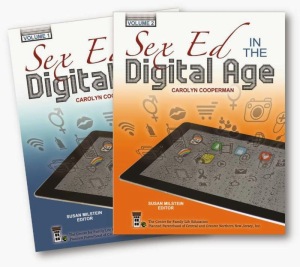 After yesterday’s lesson about technology as a form of sexual and romantic communication from Teaching Safer Sex, I thought I would pull lessons for the rest of this week from Sex Ed in the Digital Age. This brand new, two volume manual by Carolyn Cooperman (edited by Susan Milstein) delves into technology and sexuality in beautiful ways. It’s broken up into the following sections:
After yesterday’s lesson about technology as a form of sexual and romantic communication from Teaching Safer Sex, I thought I would pull lessons for the rest of this week from Sex Ed in the Digital Age. This brand new, two volume manual by Carolyn Cooperman (edited by Susan Milstein) delves into technology and sexuality in beautiful ways. It’s broken up into the following sections:
- Getting Started: Introducing teens to sex education in the digital age
- Staying Healthy: Using technology to access information
- For Better or Worse? How technology affects relationships
- Creating Safe, Inclusive Programs
- Privacy, Consent, and Safety
- Critical Decision Making in a Changing World
- Preparing Sex Educators and Parents for the Digital Age
There is also a resource section devoted to discussing a range of apps and platforms that young people use to engage digitally with their peers, both romantic and otherwise.
I’m feeling pretty excited about all of these areas of education right now, but I’m going to focus first on the lesson plans included in Section 3: For Better or Worse? How technology affects relationships. I may go on to the other sections after I’ve read through all of these, but I’m not promising that quite yet…
RELATING: ONLINE VS. IN-PERSON
By Carolyn Cooperman
Objectives
By the end of this lesson, participants will be able to:
- Compare both text messaging and face-to-face verbalizations as different forms of communication.
- Assess how online and face-to-face interactions differ.
- Describe how the sense of connection to others changes when relating electronically or in-person.
Rationale
Is text messaging and social networking comparable to face-to-face interactions? The psychologists studying such phenomena are not necessarily in agreement about whether the new technologies will ultimately prove to be advantageous or detrimental to teenage relationships. One prominent researcher warns that intimacy, and the ability to handle the give and take of conversation, is lost in text responses. The nuance of the human voice and its inflections, and the understanding that someone is not giving stock answers, affects the dynamics in relationships. Another researcher reports that for socially isolated teens, technology facilitates the development of beneficial relationships that otherwise might not be possible. In this lesson, participants get to try out both digital and direct modes of interaction, and evaluate the experience in terms of comfort level, sense of connection to others, and preferences.
This lesson plan does two things very, very well:
- Asks students to consider their own values around digital communication and to discuss those values with their peers.
- Uses a simulated text activity to invite dialogue about the effectiveness of texting versus face-to-face conversations for a range of specific needs.
One of the things I like about this is that there doesn’t seem to be a “right” or a “wrong” answer, just a discussion. Texting does have its own rhythm – and frequent users learn to read their friend’s texting pace, language choices, emojis, etc. as relevant cues to their internal dialogue. It is not communication completely devoid of non-verbal cues. This lesson plan allows students to potentially bring that awareness into the discussions in a way that is respectful of their experience of digital versus face-to-face communication styles.






